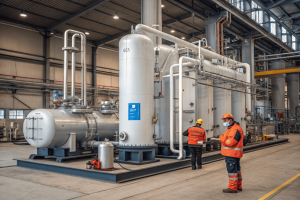What is a major environmental drawback of achieving complete combustion?
•
What is a major environmental drawback of achieving complete combustion?
You've always aimed for complete combustion because it's the most efficient process. But you find that hitting this peak efficiency also creates a massive environmental problem you're now required to solve.
The main environmental drawback of complete combustion is that it maximizes the production of carbon dioxide (CO₂). This highly efficient process converts every single carbon atom in the fuel into CO₂, releasing the largest possible volume of this greenhouse gas into the atmosphere.
For my entire career, the goal in designing any combustion system was to get it as close to "complete" as possible. Perfect combustion means you get every bit of energy out of your fuel. It's the gold standard for efficiency. The irony is that this 'perfect' process is the very thing that creates the CO₂ problem we now spend billions trying to solve. Every ton of fuel burned perfectly creates the maximum possible amount of CO₂, and now my job is to capture it.
How does the formation of nitrogen oxides (NOx) relate to high-temperature combustion?
Your plant is running efficiently at high temperatures. But now you're facing strict regulations on a different pollutant you may not have focused on before: NOx, which contributes to smog and acid rain.
At the very high temperatures required for efficient combustion, the normally unreactive nitrogen in the air breaks apart. These nitrogen atoms then react with oxygen to form various nitrogen oxides (NOx). This reaction is separate from the fuel burning itself.

I often have to explain to clients that even if their fuel is perfectly clean, they can still have an emissions problem. The air we pull into our boilers and furnaces is almost 80% nitrogen. When we crank up the heat to get better efficiency, we create the perfect conditions for that nitrogen to become a problem. It's a chemical reaction that only happens when it gets really hot, which is why we call it "thermal NOx." So, in our quest for perfect combustion, we inadvertently create another regulated pollutant.
The Heat and Air Problem
The formation of NOx is a direct consequence of the conditions needed for efficient combustion. It's a fundamental challenge that requires specific engineering solutions to manage.
- Source of Nitrogen: The primary source is not the fuel, but the air itself. Air is composed of approximately 78% nitrogen (N₂) and 21% oxygen (O₂).
- The Role of Temperature: The N₂ molecule has a very strong triple bond, making it stable. Only extreme heat—typically above 1300°C (2370°F)—provides enough energy to break this bond.
- The Reaction: Once the N₂ bond is broken, the free nitrogen atoms can easily combine with the abundant oxygen in the combustion chamber to form NO, NO₂, and other oxides.
| Combustion Temperature | NOx Formation Rate | Engineering Impact |
|---|---|---|
| Low (<1000°C) | Negligible | Less efficient combustion, not a concern for thermal NOx. |
| Medium (1000-1300°C) | Moderate | Some NOx is formed, may require some controls. |
| High (>1300°C) | High / Exponential | The primary zone for thermal NOx; requires specific controls like low-NOx burners. |
What is incomplete combustion, and what are its toxic byproducts (e.g., CO)?
You might think that avoiding complete combustion would be a good way to reduce CO₂. But this creates a different, more immediate danger from toxic byproducts that are harmful to human health.
Incomplete combustion occurs when there is not enough oxygen to burn the fuel completely. Instead of producing just CO₂ and water, it creates dangerous byproducts like carbon monoxide (CO), soot (particulates), and unburned hydrocarbons, which are highly toxic.
Early in my career, I was called to a site where a boiler was malfunctioning. The air intake was partially blocked. Instead of a clean burn, it was producing black smoke and a smell of unburned fuel. More importantly, our sensors detected high levels of carbon monoxide, a colorless, odorless gas that can be deadly. This is the reality of incomplete combustion. It's not a solution for CO₂; it's a dangerous failure state that is inefficient, wasteful, and poses a direct threat to anyone nearby.
The Dangers of Oxygen Starvation
The difference between a clean, efficient burn and a dirty, dangerous one comes down to one key ingredient: oxygen.
| Feature | Complete Combustion | Incomplete Combustion |
|---|---|---|
| Oxygen Supply | Sufficient or excess oxygen | Insufficient oxygen |
| Main Carbon Product | Carbon Dioxide (CO₂) | Carbon Monoxide (CO) and Soot (Carbon) |
| Other Byproducts | Water (H₂O) | Unburned hydrocarbons, smoke |
| Energy Release | Maximum possible | Significantly lower |
| Safety Concern | CO₂ (greenhouse gas) | CO (acutely toxic), Fire Hazard (soot) |
In short, while complete combustion has the long-term environmental drawback of CO₂ production, incomplete combustion is an immediate operational failure with severe safety and health risks.
How do different fuel types (e.g., coal, natural gas) affect the CO2 concentration in flue gas?
You are evaluating a carbon capture project. The cost and design of the equipment depend heavily on the concentration of CO₂ in your exhaust stream, which is determined by the fuel you use.
Different fuels have different carbon-to-hydrogen ratios. Fuels with more carbon per unit of energy, like coal, produce a flue gas with a higher CO₂ concentration (12-15%) than fuels like natural gas (8-10%), which has more hydrogen.
This is one of the first things I look at when designing a CO₂ recovery system. The percentage of CO₂ in the flue gas dictates the size and cost of the capture plant. Capturing CO₂ from a coal plant's exhaust is technically easier in some ways because the CO₂ is more concentrated. There are more CO₂ molecules for our solvents to find and grab. With natural gas, the flue gas is more dilute. This means we have to process a larger volume of total gas to capture the same amount of CO₂.
Fuel's Impact on Capture Design
The choice of fuel directly impacts the engineering and economic feasibility of a carbon capture installation. A higher concentration makes the separation process more efficient.
- Coal: It is mostly carbon. Its combustion produces a flue gas with high CO₂ concentration but also other pollutants like sulfur oxides (SOx) and particulates that must be removed first.
- Natural Gas (Methane, CH₄): It has four hydrogen atoms for every one carbon atom. It burns very cleanly, but because so much of the energy comes from burning hydrogen (which becomes water), the resulting CO₂ is diluted by a large amount of water vapor and nitrogen from the air.
| Fuel Type | Chemical Formula (Simplified) | Typical Flue Gas CO₂ % | Impact on Capture |
|---|---|---|---|
| Coal | C (mostly) | 12-15% | Higher concentration, easier separation. Requires pre-treatment for SOx. |
| Fuel Oil | CH₂ (approx.) | 10-12% | Intermediate concentration. |
| Natural Gas | CH₄ | 8-10% | Lower concentration, requires handling larger gas volumes. |
This fundamental difference is why a carbon capture plant designed for a coal-fired power station cannot simply be used on a natural gas-fired one. The entire system has to be engineered for the specific characteristics of the fuel's flue gas.
Conclusion
The main drawback of complete combustion is maximum CO₂ production. This efficient burn can also create NOx at high temperatures. Incomplete combustion is not a solution, as it produces toxic CO, while different fuels yield varied CO₂ concentrations affecting capture design.
You may also be interested in:

Why is CO₂ recovery technology gaining popularity worldwide?
Why is CO₂ recovery technology gaining popularity worldwide? You see headlines about carbon capture everywhere. But you wonder if it's
Read more
How is a CO₂ recovery system designed to fit different industries?
How is a CO₂ recovery system designed to fit different industries? You're under pressure to implement a CO₂ recovery solution.
Read more
How energy-efficient are today’s CO₂ recovery technologies?
How energy-efficient are today’s CO₂ recovery technologies? You want to recover CO₂, but you fear that high electricity bills will
Read more